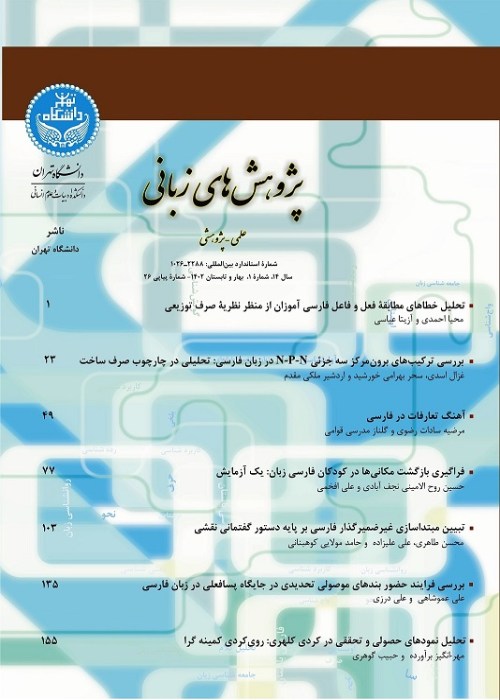Allomorph Alternation in Ezafe/Possessive Constructions in Sanandaji Kurdish: A Distributed Morphology Approach
Author(s):
Article Type:
Research/Original Article (دارای رتبه معتبر)
Abstract:
Conditions governing Ezafe/possessive marker allomorphy in Sanandaji Kurdish are of vital importance. There are four possible cases for the head noun of Ezafe construction; i.e. it can be definite and accompanied by an adjective; definite without any adjective complement; and indefinite with or without an adjective complement. Also, there are two possible cases for the head noun of possessive constructions; i.e. it is always definite, but it may be accompanied by an adjective complement or not. Amongst them, there is just one case with an evident case marker «=æ»: A definite noun phrase accompanied by an adjective reflects the Ezafe/possessive relation by linker «=æ», otherwise «=i» inserts. Hence, the rationale behind the aforementioned morpho-syntactic conditions is a challenging issue in Ezafe/possessive constructions. Furthermore the distinctive interpretation of the two constructions; is not to be disregarded just the possessive construction bears the meaning of possession. The present paper aims at investigating Ezafe/possessive constructions from a Distributed Morphology view and provides an analysis of their derivations which explains the structural similarities and constraints determining the alternation of case marking. It is supposed, the value of features in «Ez» determines the winner of the competition between «=æ» and «=i». Accordingly, when uninterpretable features in node Ez are valued as [Ez, +MOD, +DEF], «=æ» inserts into the node, and in other three cases, based on the under-specification principle «=i» inserts. Also, the difference in morphological features of the Complement of EzP nodes is responsible for the distinctive meaning of Ez- and Possessive constructions. In possessive constructions, the head of the adjective phrase, as a complement of EzP, contains an uninterpretable feature [POSS] which must be satisfied by merging EzP node with a possessive complement. Therefore the difference is related to the complement of EzP not the Ez node itself.
Keywords:
Language:
Persian
Published:
Language Research, Volume:10 Issue: 1, 2019
Pages:
39 to 58
magiran.com/p2007448
دانلود و مطالعه متن این مقاله با یکی از روشهای زیر امکان پذیر است:
اشتراک شخصی
با عضویت و پرداخت آنلاین حق اشتراک یکساله به مبلغ 1,390,000ريال میتوانید 70 عنوان مطلب دانلود کنید!
اشتراک سازمانی
به کتابخانه دانشگاه یا محل کار خود پیشنهاد کنید تا اشتراک سازمانی این پایگاه را برای دسترسی نامحدود همه کاربران به متن مطالب تهیه نمایند!
توجه!
- حق عضویت دریافتی صرف حمایت از نشریات عضو و نگهداری، تکمیل و توسعه مگیران میشود.
- پرداخت حق اشتراک و دانلود مقالات اجازه بازنشر آن در سایر رسانههای چاپی و دیجیتال را به کاربر نمیدهد.
دسترسی سراسری کاربران دانشگاه پیام نور!
اعضای هیئت علمی و دانشجویان دانشگاه پیام نور در سراسر کشور، در صورت ثبت نام با ایمیل دانشگاهی، تا پایان فروردین ماه 1403 به مقالات سایت دسترسی خواهند داشت!
In order to view content subscription is required
Personal subscription
Subscribe magiran.com for 70 € euros via PayPal and download 70 articles during a year.
Organization subscription
Please contact us to subscribe your university or library for unlimited access!


